- Home
- M. G. Herron
The Auriga Project Page 2
The Auriga Project Read online
Page 2
“Do you want to go over the stage directions one more time?” she asked.
“I have something for you.”
“What? Now?” Eliana said, distracted from her original intention.
“We’ve waited years for this, what’s another five minutes?” He withdrew something from his coat pocket—a velvet box that fit in the palm of his hand.
Eliana took it with shaking hands and eased open the lid. She gasped. “Amon…my God, it’s beautiful.”
Amon carefully lifted a silver ring with a large diamond, black as night, from the velvet cushion. He slipped it onto her finger.
She tilted her hand this way and that. It fit perfectly. The smoky translucence of the stone gave it a deceptive depth—she gazed into it and saw tiny stars, microscopic galaxies, swimming in its core.
“It looks just like your mother’s ring, except for the gemstone…how did you find a diamond this color?”
Amon’s mouth turned up at one corner. “I saw how upset you were after you lost the ring in Cairo, so I had it remade from old photographs of my parents. Except for the carbonado—that’s what the black diamond’s called. It was harvested from a meteorite.”
“It’s incredible,” she said. “Thank you.”
Amon gathered her into his arms. “It’s I who should be thanking you. For being here with me tonight, and for working so hard to put this whole thing together. It means so much to me.”
“Please. I had help! Diane is a miracle worker, I’m telling you.” Her heart warmed at his praise. And yet, deep down, she did not register contentment. Putting together the party did not give her the satisfaction she had expected, merely relief that it would soon be over. She missed the rich history of archaeology work, the possibility of joy that lay dormant in even the most tedious excavation.
“You’re being modest, as usual,” Amon said. “Without you, none of this would have been possible.” He gestured not merely to the party outside, but to the lobby, the building, the campus and everything it represented.
Eliana smiled and took a deep breath. A curious thing had happened while she adjusted to working as a Fisk Industries employee. For one, she was glad to be able to spend more time with Amon after being on the road so often. Her travels and his work schedule had been erratic before.
More importantly, their careers had never crossed paths until now. Working with him every day introduced a new aspect to a ten-year-old marriage that had grown, if not stale, then perhaps complacent. She supposed both of them were at fault to a certain extent.
She forgot all that when she saw how Amon’s employees smiled when he walked into a room, how his team of engineers looked up to him, and how the new hires, specially the interns, spoke together in hushed whispers after a chance meeting with “Amonfisk,” and how they always called him “Amonfisk”—one word—like he was a rock star.
Their adoration for him had ignited a spark of passion in her heart again, something she hadn’t felt in recent years of their marriage.
And yet some part of her knew she would never be content if her life revolved around planning events—even important ones like this. It wasn’t enough to make her truly happy.
“I love you, Amon,” Eliana said. “And I’m so proud of what you’ve accomplished.”
“But?”
“But I miss my job. It’s been so great getting to spend time together for a change, but I’m not ready to give up on it yet.”
“I would never ask you to.”
“You mean that?”
“Of course. I’ll fire you right now, put you on a plane to Greece…or Turkey! I’ll buy a pyramid and ship it home brick by brick if that’s what you want, darling.”
Eliana laughed. In that moment, she fell in love with him all over again. “I know you would.”
She stepped back out of his embrace and rotated the new ring on her finger, thoughtful this time instead of anxious. She imagined how, once the media got over the initial shock of Amon’s announcement, their lives might once again return to normal. Eliana would step down from her role as professional wife and resume her hunt for grant money to build a new organization. Though her life had taken a yearlong detour, she felt a passion for dig trips and old ruins and unanswered questions about ancient cultures resurfacing. She was excited and scared and in love, and it made her feel alive.
“Well,” she said when she remembered to breathe. “Are you ready?”
“No way,” Amon said. “Once I get out there, I’ll be fine. It’s this next part I hate.” He tugged at his damp collar with one finger.
“I know,” she said as she took his hand.
2
The Auriga Project
Ahundred bursts of light blinded Amon as he stepped through the doors. Photographers crowded around them, pushing cameras into their personal space. He tensed at each flash, involuntarily gripping Eliana’s hand tighter. She kept moving. By focusing on putting one foot in front of the other, he did, too.
Eventually, they ascended a set of metal stairs, which were then removed to clear the area for the demonstration. The swarm of photographers regrouped behind the rope delimiting the media area at the foot of the stage.
Onstage, with the cameras at a reasonable distance, Amon took a deep breath. He patted Eliana’s hand and left her next to Reuben, who stood clapping with Lucas, Wes McManis, Herr Buch, Dr. Badeux, and a few other LTA representatives who had flown in from Europe, Asia, and Africa. As Amon approached the microphone, they took their seats.
The audience followed suit, and the applause tapered off. Amon continued to sweat beneath the glare of overhead lights, but there was nothing to be done about it now. He glanced over the crowd as he made his way to the microphone. He had decided against a podium, so as not to obstruct anyone’s view. Even so, with the quad full of people, for a moment he felt uncomfortably exposed.
Taking another deep breath, he fought down his anxiety. Dusk faded slowly into night as several hundred pairs of eyes looked expectantly toward him. He waited until the murmuring died down to a whisper. Then he waited a moment longer. So much effort had led to this moment that he felt it deserved to be savored. He stood up a little straighter.
When the audience began to fidget, Amon cleared his throat and spoke into the silence. “Ten years ago, Fisk Industries began work on a transportation project with the Lunar Terraform Alliance. It’s been a long and difficult journey. There have been setbacks; there have been failures. Some people out there—some of you here tonight—told me that I was wasting my time. That we were throwing money away trying to accomplish the impossible.
“I thought so myself, at first. But after working closely with the scientists at the LTA, after getting to know the astronauts and engineers that brave death on a daily basis to build and maintain the Lunar Station’s three biodomes, I came around to a new way of thinking.”
Even as he spoke, a low rumble caused the entire quad to vibrate. Without turning to look, Amon knew that a semi-circle of sod behind the stage had telescoped open, and a two-hundred-foot-tall, arch-shaped array of silicone and metal nodes had climbed skyward behind him.
“Fortunately,” he went on, his voice barely carrying over the audience who murmured in surprise, “the advances we’ve made in particle physics over the past several decades have given us new knowledge, and we’ve applied it to solve an old problem. As they say, we stand on the shoulders of giants.”
The base of the arch rose until it was level with Amon’s feet, seamlessly extending the stage. Centered beneath the arch, a sphere of concentric blue-green alloy rings encircled a slightly raised platform. The sphere of rings was twenty-five feet in diameter and held in place with magnets so they could spin freely. Rotating slightly, the rings came to rest so that a space tall enough for an SUV to drive through conveniently opened onto the ramp leading up to the platform in the sphere.
The choreography was timed perfectly. Amon likened the visual effect of the entire contrivance to a piece of modern art—sp
arse and powerful, delicate and surreal. With the glass-walled flagship building of Fisk Industries visible through its empty spaces, it filled one with a great hope…and a great sense of skepticism. To most, space travel meant a rocket or a plane, a flying machine with wings and thrusters. But this?
Amon took the microphone from its stand. As he crossed the stage, he reached out and let his fingers skim the cool alloy rings whose contours he knew so well. He moved past the sphere and stopped in front of an arrangement of displays: two floor-mounted holographic projectors, and a wide glass touch screen. The other screens arranged around the quad, the ones that had been showing his favorite rocket launch clips, faded to black and were replaced with a video feed of the pockmarked lunar surface and a concave reflection of a biodome in the background.
Amon traced the multiple redundant power cables below the stage in his mind. They were hardwired, connecting the entire apparatus to the lab below ground, and from there to the particle accelerator that powered the Hopper. The official name was the Translocator, but in the years before it had an official title, he and Reuben had begun referring to it as the Hopper—and that’s how he still thought of it.
As they had rehearsed, Reuben rose from his seat next to Eliana and joined Amon at the console. He powered up the holo displays with a sharp upward motion of both arms. The holos kicked on, illuminating a model of the arch in miniature, and controls like the cockpit of a fighter jet arrayed themselves in the air.
Amon continued his speech, moving back to the center of the stage. “The biggest obstacle faced by the team of scientists and engineers at the Lunar Station has always been to establish a reliable supply chain. They’ve experienced no end of problems in their effort to get the supplies they need, when they need them. As a result, many lives have been lost—to equipment failures, to accidents, to materials and tools forced to perform past their intended lifecycles of use. Furthermore, the energy crisis on Earth has made an impact on all our lives, not least our ability to continue spending billions building and launching inefficient rockets. As a result, the Lunar Station’s original plans have been pushed back decades from their original projections.”
Reuben made a few gestures, and the particle accelerator came to life beneath them. As energy flowed into the stabilizing poles of the arch, a thin keening noise pierced the air like the sound of a camera flash charging, audible across the entire campus.
The audience tensed and shifted in their seats. They exchanged worried glances. Amon could understand their reaction. If he didn’t know what to expect, that sound would have been…unsettling.
“The breakthrough in molecular reassembly made by Ortega’s team at the European Space Agency opened our eyes to the possibilities. Building on their research, we have constructed a mechanism capable of translocating objects directly to the lunar surface.”
Under the spotlights, Amon saw everyone in the crowd glance around uneasily. Molecular reassembly and translocation were touchy subjects. They were the reasons the LTA had insisted on keeping the Auriga Project under wraps until the process had been stabilized.
First discovered in a secret lab in Germany in the 1930s, Nazi fringe scientists pioneered the molecular reassembly process. Nearly a century later, when the experiment was finally declassified by the German parliament, it was reproduced on a small scale by Ortega’s team at the ESA and in private labs around the world. The ESA upgraded its experiments to live subjects—lab mice—too quickly and were shut down shortly after animal rights activists learned that the subjects were being reassembled with missing limbs, with absent organs, or not at all.
The scientific community caught wind of it and hurriedly canned all the open projects. Major publications like WIRED and Popular Science and the academic community as a whole lambasted the ESA for green-lighting those projects, and deemed molecular reassembly to be “unsafe and irresponsible.”
Since then, no one had attempted to recreate the process, let alone attempt it on such a large scale.
Until now.
Amon was well aware of the scientific trail of errors he proposed to inherit when the project began. His experiments were classified and funded by the LTA, so he had the buffer he needed to conduct them in secret. More to his advantage, an engineering problem could be solved without putting any lives at risk. No activists would be picketing his lab as long as he didn’t test the process on living subjects. Instead, his team focused on transmitting homogenous uniform materials, and then upgraded to mixed nonorganics like glass and metal and plastic and clay. Eventually, they were able to translocate batteries and, finally, computer parts, flawlessly. They’d moved into organic trials shortly after that—plants and wood and dirt, then small creatures. Unlike Ortega’s team, they never had any issues with lab mice. The activists could complain if they wanted, but now it was too late. They hadn’t had any failed translocations in years.
“Ladies and gentlemen,” Amon said, gesturing to the machine that towered over him, the fruit the past ten years of his life were about to bear, “I give you the Auriga Project, the future of space travel, the Translocator.”
A halfhearted round of applause rose from the crowd. He had expected hesitation. They would have to see it to believe it.
“We’ve taken every precaution for the purposes of this demonstration,” Amon went on. “When Ortega’s team first pioneered the molecular reassembly process, it was far from safe. We know that, and have made significant advances. Now, a man can step through the Translocator and come out on the surface of the moon as easily as he can walk across the street. We’ve met with the approval of an LTA oversight committee, a board of top-notch scientists picked from all over the world—many of whom are here with us tonight. So we can all witness the demonstration, we’ll be using a twelfth-generation rover named Carbon to help us out. He’s waiting in the lab below. Reuben, would you bring him up here, please?”
Reuben’s fingers twitched, and a series of glyphs lit the top of the screen, spelling out the parameters for the translocation. The great arch came to life. The keening noise amplified its pitch and intensity until it climbed above the audible range for the human ear and went silent. Blue-white sparks of energy flickered between nodes of the arch.
The sphere of concentric rings around the platform spun, collecting the energy from the outer arch and concentrating it inside the sphere. The sphere spun, blurred, and radiated a soft turquoise brightness.
Then the light was gone, the rings wound down, and a lunar rover appeared on the platform—its squat, wheeled form perfectly intact.
The crowd exploded with applause. Reuben inputted a few more commands on the console and the rover rolled to Amon’s side.
Amon tried to hide his smile. This was a parlor trick compared to what was coming next. The appearance of the rover had been meant to warm up the crowd and dispel their initial doubt. Carbon had merely been transported from the lab a few floors below ground. The surface of the moon, however, was hundreds of thousands of miles from Earth, and moving at an incredible velocity.
“Tonight, Carbon will be making the journey to the lunar surface. He’s made this journey many times in our years of testing, but tonight is the first time he will do so in public. A team is waiting for him in the research biodome of the Lunar Station.”
Reuben motioned, and a new set of parameters appeared. Amon waited for him to nod then said, “My wife, Eliana, will help me christen this maiden voyage. Sweetheart, if you’ll do me the honor?” He held out his hand.
Eliana walked across the stage and took Amon’s hand.
“Traditionally, you’d break a champagne bottle across the hull,” Amon said to the audience. “But I don’t know if that’s recommended when we’re working with electronics.” When Eliana laughed, the crowd laughed along with her.
Amon and Eliana met Reuben at the control unit. As rehearsed, Eliana stood between her husband and Reuben in front of the screen.
Reuben keyed in a few commands, and a series of calculati
ons scrolled up. Amon double checked Reuben’s work as he did it, verifying energy levels coming in from the particle accelerator and calculating the moon’s position, rotation, and velocity in real time. They didn’t have to speak. Amon knew everything was going according to plan on Reuben’s end by his grunts of approval.
When they were ready, Reuben verified radio communication with the lunar team then cleared the display and brought up a green Initiate button. The button was strictly for show and big enough for the cameras to make out.
Reuben nudged the button’s digital image across the display so it was in front of Eliana. She reached out her left hand—her new ring glittered. When her fingers came into contact with the screen, she pulled her hand back sharply, as if she had been zapped by an electric shock. She rubbed her fingers and frowned.
“Are you okay?” Amon whispered into her ear, careful to hold the microphone away from his mouth.
“I’m fine,” she said, quick to put a smile back on her face for the cameras. She moved a few steps from the display—not part of the stage directions they had rehearsed, but Amon was too distracted by what happened next to give it much thought.
The machine screamed as it came to life. The keening noise didn’t go sub audible, but escalated into a banshee’s screech. Electricity popped loudly across the arch, and great tree-like shapes of blue-white lightning shot into the air in every direction.
“Reuben, what’s happening?” Amon shouted, turning back to the display. A graph that measured the energy output from the particle accelerator careened into the danger zone. Reuben gestured wildly, trying to regain control of the apparatus, but the holo controls were no longer responding to his increasingly frantic motions.
“It’s unresponsive. Initiate emergency shutdown!”

 Starfighter Down
Starfighter Down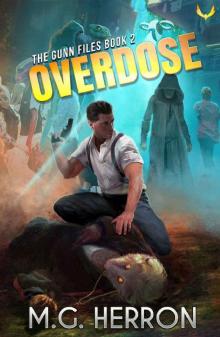 Overdose (The Gunn Files Book 2)
Overdose (The Gunn Files Book 2)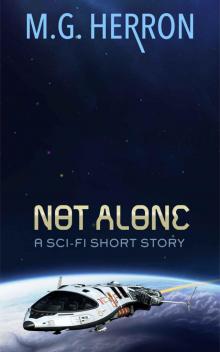 Not Alone
Not Alone Not Alone: A Sci-Fi Short Story
Not Alone: A Sci-Fi Short Story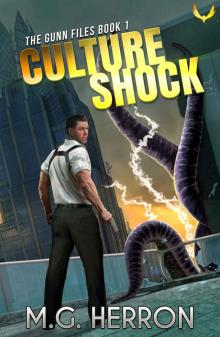 Culture Shock: A First Contact Mystery Thriller (The Gunn Files Book 1)
Culture Shock: A First Contact Mystery Thriller (The Gunn Files Book 1)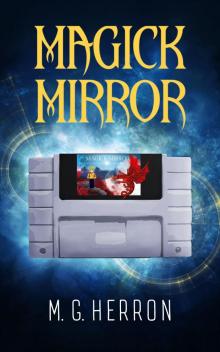 Magick Mirror
Magick Mirror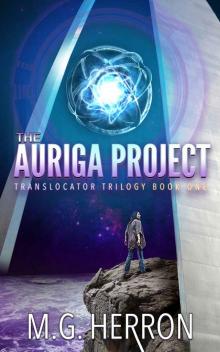 The Auriga Project
The Auriga Project The Auriga Project (Translocator Trilogy Book 1)
The Auriga Project (Translocator Trilogy Book 1) Tales of the Republic (The Complete Novel)
Tales of the Republic (The Complete Novel)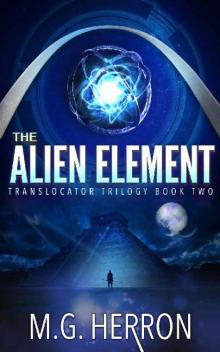 The Alien Element
The Alien Element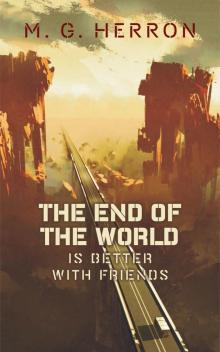 The End of the World Is Better with Friends
The End of the World Is Better with Friends